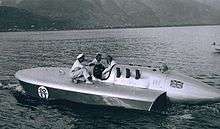Blue Bird K3

Blue Bird K3 is a hydroplane powerboat commissioned in 1937 by Sir Malcolm Campbell, to rival the Americans' efforts in the fight for the world water speed record. She set three world water speed records, first on Lake Maggiore in September 1937, then later twice raising her own record.
The name "K3" was derived from its Lloyd's unlimited rating, and was carried in a prominent circular badge on the forward hull.
Construction
After Campbell's achievement of the 300 mph land speed record with Blue Bird in 1935 he retired from the land speed record. Shortly afterwards he switched his attentions to the water speed record, at that time dominated by the American Gar Wood.[1]
Fred Cooper of Saunders Roe was commissioned to design a small hydroplane powered by the same Rolls Royce R engine used in Blue Bird, and also in pairs in Segrave and Kaye Don's Miss England boats. Of the three individual R engines used by K3, one had previously run in Blue Bird and one in Miss England.
Unlike Gar Wood's multi-engined monsters, Blue Bird was designed for a single engine, and the smallest possible craft to carry it. She was 23 feet long, compared to 38 feet for Miss America X. Her estimated top speed on paper was to be 130 mph.[1] It was usual at this time for English hydroplanes to have their engines mounted as far astern as possible (Gar Wood disagreed, and had pointed this out to Segrave). K3 took this a step further and had a narrow central nacelle that overhung the transom of the stern. This rearward weight distribution encouraged planing, but could lead to some peculiar attitudes when setting off at slow speeds, as the whole boat appeared to be sinking by the stern.
Records
On 1 September 1937, at Lake Maggiore on the border between Switzerland and Italy, K3 set a record of 126.32 mph,[2] breaking Gar Wood's previous 5-year-old record.[1] The next day she improved this to 129.5 mph.
Breaking the design speed of 130 would require another year, when on 17 August 1938 at Lake Hallwyl in Switzerland at 130.91 mph(210.63 km/h).
Ventnor "three pointer"
Despite these records, Campbell was dissatisfied with their small margin over the previous record (6 mph).[1] K3's hull was a single-step hydroplane, as already used for Miss England. This lifted half of the hull clear of the water, reducing drag upon it. A new idea from America was the "three point" hydroplane, where the forward hull is divided into two sponsons and the boat rides at speed on just these and the propellor. This reduces the wetted area (and drag) still further. It was not possible to convert K3 to this hull form, so Campbell began work on a whole new boat, K4, re-using the same engine.
Restoration
The original boat was restored at Filching Manor in East Sussex and is now in working order. The boat was stripped down and fully rebuilt using parts to the original standard. (http://www.k3bluebird.com)
She will run on the regatta course at Henley-on-Thames during the Traditional Boat Festival on 18-19 July 2015. (http://www.tradboatfestival.com/#!bluebird-k3/c9ig)
External links
References
Further reading
- Harris, Fred (2000). Skimming the Surface. Ainsdale Press.
- Tremayne, David (2005). Donald Campbell: The Man Behind the Mask. Bantam Books. ISBN 0-553-81511-3.
- Villa, Leo (1976). The World Water Speed Record.